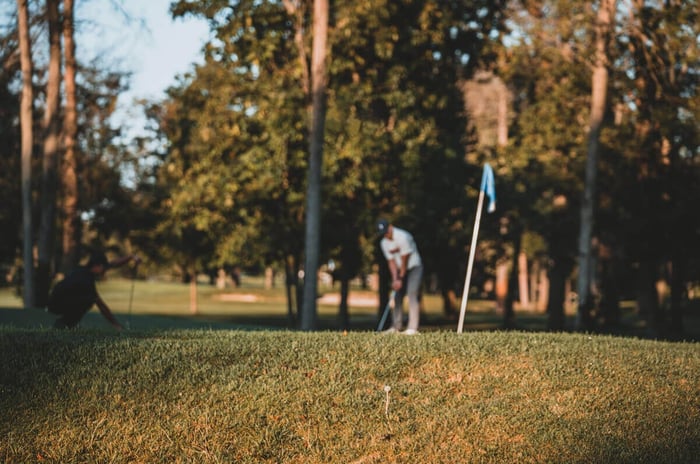![]()
Shot tracking is a practice used by many professional golfers to improve their scores. It helps them dissect their game into segments they can focus on for improvement, but be aware there's a little more to it than that. There is an art to shot tracking. Keep reading to adopt the exercise of shot tracking into your routine and start seeing your scores drop!
Why Shot Track?
It may seem overwhelming to document your shots on the golf course. I mean where is the fun in that!? I’ll tell you, the fun is when you have less and less strokes to document. Seriously, when you top the ball and force yourself to write down an extra shot in the fairway, it hurts. Use that pain to drive you to improve. Not to mention that data can be used to identify patterns in your game that need the most work!
What About Etiquette?
Who really wants to be on their phone during a round of golf? In most cases, having your phone out on the course is frowned upon. While there are several apps that will help you track your shots, there is something special about using that little mini pencil and a piece of paper on the course. This is also why we created our Golf Shot Survival Guide instead of an app, there’s just something special about actually holding it in your hands.
Carry a small notepad with you on the course, simply fill it in when you fill in your scorecard after each hole. It literally only takes a few extra seconds. If you want an app to help you calculate your percentages and identify patterns, you can always plug in the numbers when you are relaxing at home, and away from the course.
When Should I Shot Track?
Shot tracking is a tool, not a chore. If you just want to enjoy the day and feel the wind in your hair after every shot instead of taking the two seconds to write down each shot, that’s fine. You’ll simply want to try to get enough rounds recorded to have reliable data to reflect on, or share with your instructor. It’s even more helpful to track rounds at your home course where you are most likely to find patterns in your game.
What Shots Should I Track?
Shot tracking shouldn’t be a mindless documentation of every shot on the course. You will just be wasting your time. Stressing over every shot and looking at your golf statistics with a magnifying glass can actually be harmful to your game, but there are a few stats we should focus on.
Tracking Within 100 Yards
Every shot within 100 yards is crucial. This is where the magic happens. It is necessary to track all of these shots. Building confidence in your game within 100 yards is a game changer on the golf course. Keep track of these shots in order to see areas of improvements. Make a note of the club you used and how far out you were. If you notice that you are grabbing your 56 degree for the 90-100 yard shots, but you are missing the green, then it’s time to dial in that yardage or change clubs.
Star Solid Chips
While you are tracking the shots within 75 yards, make a special note of those chips that you stick within 3 feet. If you are tracking with pen and paper, a simple star next to these holes will do. Or, most apps will allow you to make a note of how close your chip came to the hole. These chips deserve a special star because in most cases a three foot putt should go in. As you work on your game, you’ll be able to give yourself more and more stars!
Track Dangerous Drives
You don’t need to necessarily track every drive on the course. Even on the tour, the Driving Accuracy (how many drives hit the fairway/green) is roughly around 65%. This means that even the best professional golfers will land their drive off the fairway about 35% of the time. Yet, those pros are consistently scoring under par.
Driving Accuracy is not the most important stat to keep. If your drive puts you in danger, or creates the need to punch out to the fairway, then it needs to be tracked. You might be thinking, “I already know that most of my drives put me in danger.” I get it, you may consistently feel that pain. However, if you start tracking them now, then you can better identify the patterns to improve your game.
Track When You’re Dancing On Par 3’s
Tracking every time you hit the green on a par 3 is not only a way to reward yourself for a great shot, it is also an opportunity to dial in the holes where you missed the green. This also comes with a caveat; if the putt is impossible, don’t track it. The point is to document the par threes that put you in position for a birdie putt. Look at the yardage of the holes you missed, and improve on that yardage the next time you are an the range.
Track Those Horrible Three Putts
I know this is painful. While you are tracking how many strokes you have within 100 yards, give yourself an “X” on the holes where you 3 putt. Tracking 3 putts is a chance to see when you need to go back to that putting green after the round and make 50 putts within 3-5 feet. Of course, there will be some courses/greens that will have a higher putt count than others, so take the data with a grain of salt and don’t beat yourself up too much. Just like tracking dangerous drives, think of three putts as an opportunity to see those strokes drop as you improve.
How do I Avoid Shot Tracking “Burn Out”?
The truth is, shot tracking can be tiresome and annoying at times. Unfortunately, not all of us have caddies and coaches to follow us around to track each shot. When you have to track your stats on your own, there is a risk of burn out. One way to help with avoiding burn out is to make it fun!
Create games for yourself when tracking shots. One game is to mentally create a separate hole for yourself within 100 yards. While you are tracking, think, “If I make this in the hole within three shots, I made par.” Then, “If I get this in the hole in two shots, I’m at a birdie.” If you hole it from 100 yards out… well it’s your lucky day. Go buy a lottery ticket!
On the topic of betting, get your golfing partners involved in your shot tracking practice. If everyone in the group is tracking their shots, there is opportunity to bet on the group’s “lowest putter” or “best chipper” for the day. By inviting everyone to track their shots, it’s less awkward when you take an extra few seconds to record each shot at the end of the hole.
Conclusion
Shot tracking is no longer only for the pros. Golfers of all levels can improve their game more effectively by accurately identifying patterns and areas of improvement. Soon enough you’ll have less and less shots to track.





